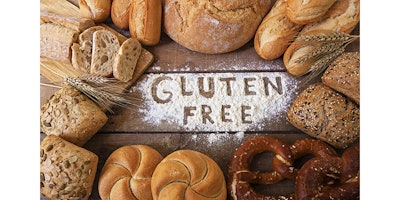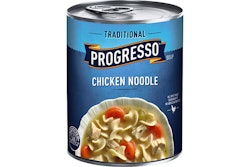
 Shutterstock
Shutterstock Cynthia Kupper, CEO, Gluten Intolerance Group of North America
Cynthia Kupper, CEO, Gluten Intolerance Group of North America The strong interest in gluten-free food products that consumers have demonstrated over the past decade is far from waning. In fact, the gluten-free food category grew 136 percent from 2013-2015, reaching $11.6 billion, according to market intelligence agency Mintel. Extending well beyond the approximately 1 percent of the population that has celiac disease, the appeal of gluten-free products likely plays into the overall growing interest in ingredient disclosure and "free-from" labeling, as well as general interest in eating foods that consumers perceive to be more healthy.
In light of this trend, the temptation for food marketers to claim their products are gluten-free is obvious, as is the potential for confusion over what such claims mean. This potential for confusion led the FDA in 2013 to issue a rule that any product labeled “gluten-free” must contain a gluten limit of less than 20 ppm (parts per million).
Ensuring compliance for products labeled "gluten-free"
While the FDA rule improved clarity in the marketplace concerning the meaning of gluten-free claims, it is important to note that the FDA does not mandate procedures for ensuring that foods meet the gluten-free standard and does not make a coordinated effort to monitor whether gluten-free claims are accurate. Establishing sufficient production procedures, appropriate testing methods and other safeguards are left to food manufacturers themselves.
Mistakes in labeling foods as gluten-free can be costly to manufacturers as well as potentially dangerous for consumers. For example, manufacturers responsible for a contamination, even if inadvertent, face the prospect of fines, expensive voluntary or involuntary recalls, damage to brand reputation and possible litigation by consumers.
Although the FDA has not mandated Standard Operating Procedures (SOPs) that food manufacturers must follow when using a gluten-free label, it did publish a guidance document which recommends that manufacturers:
"use effective measures to ensure that any foods labeled as “gluten-free” comply with our requirements; such measures may include:
- testing the ingredients to determine their gluten content;
- requesting certificates of gluten analysis from ingredient suppliers; or
- participating in a third-party gluten-free certification program.
While food manufacturers have the option of setting up purely internal procedures to ensure compliance with the FDA's requirement, accomplishing this can be a complex task, particularly in facilities that do not exclusively process gluten-free products. Achieving compliance may involve implementing safeguards such as segregated production lines and areas for receiving and storing ingredients, developing procedures for proper handling and labeling of ingredients, determining engineering parameters for air handling systems, equipment and water and pressure controls and determining appropriate sanitation procedures, among other considerations.
The benefits of third-party certification programs
Employing the expertise of a third-party gluten-free certification program as the FDA suggests holds a number of potential benefits for a food manufacturer. It reduces the risk of improperly designating a product as gluten-free and gives the manufacturer the credibility, recognition, and support that they have provided a gluten-free product meeting or exceeding the FDA standards. Audits conducted by certification inspectors also verify that the company is guided by and meeting high standards in producing their product.
With third-party certification, manufacturers can save valuable time and resources that would have been spent administering purely internal gluten-free programs and answering questions regarding the gluten-free status of their products. Certification audits are conducted in each facility producing certified products. The audit frequency is determined by the risks associated with the ingredients, manufacturing facility and products. Audits may be announced or unannounced.
Certification audit considerations
A certification examination covers the facility's gluten program and its implementation as well as product and ingredient testing. The program components typically reviewed include:
- The management system, including procedures
- Purchasing and receipt of raw materials
- Facilities and equipment
- Production processes
- Cleaning processes and validation of cleaning, and
- Training and internal reviews to drive continual improvement
The third-party inspector will review a manufacturer’s SOPs related to ingredient purchase and review production, cleaning, allergen training, recall programs, packaging and other aspects of the production.
Certification organizations may work with other inspection agencies and independent auditors who have years of experience performing Hazard Analysis and Critical Control Point (HACCP) compliance audits, as well as organic, Global Food Safety, and kosher audits of companies worldwide. Inspectors may also have extensive experience with quality control and safety programs in plants. Based on a thorough review of relevant documents, the site audit and other factors, the inspection may identify departures from best practices that must be corrected before certification can be issued.
The third-party certifier defines minimum product, equipment and raw material testing requirements. These requirements may exceed those required by the FDA. For example, some certifications require no more than 10ppm of gluten to be present in a food products receiving certification.
Determine whether a third-party certification program adheres to appropriate ISO standards
One important distinction to look for in choosing a third-party certification program is whether that program follows standards set by the International Organization for Standardization (ISO) and, if so, the nature of the ISO standard to which it conforms.
Distinguishing between the following two ISO standards is of particular importance:
- ISO 17065 is an International Standard that specifies requirements for bodies certifying products, processes and services. The observance of ISO 17065 is intended to ensure that the certification body certifies products, processes (management systems and production procedures) and services in a competent, consistent and impartial manner.
- ISO 17021, by contrast, is an International Standard that specifies requirements for bodies certifying management systems. The observance of ISO 17021 is intended to ensure that the certification body certifies management systems in a competent, consistent and impartial manner.
In other words, when a gluten-free certification organization conforms with ISO 17065, that conformity relates to the gluten-free certification of the management system and the products of the company receiving certification as opposed to being limited to a certification pertaining to the certified company's management system as is the case with ISO 17021. A certification organization conforming to ISO 17065 will specify the ppm standard to which products must conform to be certified. By contrast, certification of a management system alone pursuant to ISO 17021 only certifies that the management system is adequate to produce safe, gluten-free products; it does not certify the ppm levels to which products adhere, which may actually vary between companies with a certified management system.
Accurate gluten-free labeling is in the best interests of consumers and manufacturers
Gluten-free labeling provides an important benefit to consumers by giving them confidence that a product they are purchasing meets applicable gluten-free standards. This provides valuable information that consumers can use when making purchases and saves the consumer time that would otherwise be required to ascertain the gluten-free status of products from a manufacturer.
In turn, manufacturers can build good will and brand reputation with consumers by meeting their desire to know more about the food products they purchase and consume.
About the author
Cynthia Kupper is CEO of the Gluten Intolerance Group (GIG) and is a registered dietitian and expert in celiac disease management. GIG’s food safety certification programs, the Gluten-Free Certification Organization (GFCO) and Gluten-Free Food Services (GFFS), have been recognized leaders in the gluten-free community for more than 20 years. The GFCO certification logo is the symbol of trust for the gluten-free community, with more than 34,000 products certified worldwide. For more information, visit www.gluten.org.























